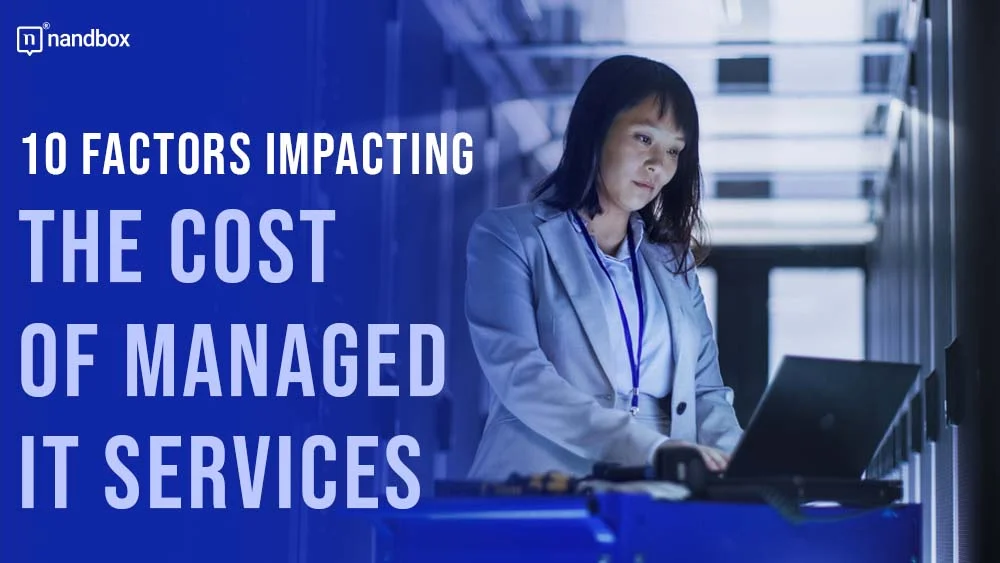10 Factors Influencing The Average Costs For IT Managed Services
Key Takeaways:
- Selecting the Right Pricing Model is Essential: Costs vary significantly based on the chosen pricing model, making it crucial to match the model with business needs.
- Service Complexity Influences Costs: More comprehensive IT services require higher investment due to their complexity and scope.
- Consider External Factors: Industry compliance, provider location, and market dynamics all affect the pricing of Managed IT Services, impacting overall budget planning.
Feeling overwhelmed by the ever-changing IT landscape? Running a business is hard enough without the constant worry of cybersecurity threats, outdated systems, and technical glitches. Managed IT Services (MITS) can be a game-changer, providing a holistic approach to ensure your technology infrastructure remains robust and efficient.
However, with a variety of service providers and diverse pricing structures, understanding the exact cost of MITS can seem daunting. That said, this article will shed light on the key factors that influence the average cost for IT managed services, empowering you to make a confident choice for your business.
What Are Managed IT Services?
MITS is all about outsourcing admin and management tasks to an external provider to streamline operations and reduce costs. This service model, exemplified by solutions like Network 1’s Managed IT, is widely used by companies to manage their IT infrastructure and operations efficiently. Managed IT providers can take a wide array of tasks off your plate – everything from keeping networks running smoothly to safeguarding data, updating software, and offering technical support.
Standard Pricing Models In MITS
Understanding these models is crucial for businesses to select the most cost-effective IT management strategy. Here are the most common pricing models used by Managed IT Service providers:
- Per-Device Pricing: This model charges a flat fee per device monitored or managed each month. It is straightforward and predictable, making it suitable for businesses that want a clear overview of costs for IT managed services relative to their inventory of equipment.
- Per-User Pricing: This model works like per-device pricing, but costs are calculated based on your number of users instead of devices. This user model is particularly beneficial for businesses where employees use multiple devices, as it simplifies billing and scales easily with the number of employees.
- All-Inclusive Pricing: Also known as the flat-fee pricing model, this approach charges a single, fixed fee for all the IT services a company requires. It offers unlimited IT resources and is favored by small businesses that prefer predictable budgeting and extensive IT support.
- Tiered Pricing: Providers offer various service packages at different price points based on what’s included. Businesses can choose the package that fits their needs and budget, with flexibility to upgrade or downgrade as required.
- A La Carte Pricing: This user model allows businesses to select and pay for only the specific services they need. It offers maximum flexibility and can be ideal for companies with highly specific IT requirements or those looking to supplement their existing IT capabilities.
Factors That Impact The Price Of Managed IT Services
Getting a grip on these different factors gives businesses a leg up when it comes to budgeting for and selecting the ideal IT service provider. Here’s an in-depth look at the key variables that tend to impact costs:
- Service Scope And Complexity
The scope and complexity of the services required are major determinants of cost for IT managed services. The scope can vary from basic system monitoring all the way to full-fledged comprehensive management covering proactive support, cybersecurity, data backup, and disaster recovery operations. More complex networks and a higher number of servers or endpoints mean greater effort and resources are needed. This not only increases operational complexity but also demands higher skill levels from the managed IT service provider, leading to higher costs.
- Company Size And Scale
The size of a company plays a critical role in determining IT service costs. Larger organizations typically have more complex IT needs due to more users, devices, and potential vulnerability points. This complexity increases the workload for managed service providers (MSPs) in terms of maintenance, monitoring, and management, which, in turn, elevates the cost. Furthermore, larger companies often require a more robust infrastructure and a higher level of service availability, both of which contribute to increased costs.
-
Level of Service And Support
The level of service and support selected by a company directly impacts the costs for managed IT services. Options vary widely, from minimal monitoring services to full management packages that include extensive support, cybersecurity protection, and proactive IT strategies. Higher levels of service involve more comprehensive care and preemptive management, which can significantly increase the service cost. Companies must balance their needs for extensive support against the higher costs those services entail.
- Technical Requirements
Specific technical requirements can also influence the costs for managed IT services. For instance, companies that use specialized software for their business operations, such as custom CRM systems or industry-specific applications, require IT service providers skilled in those technologies. Additionally, any unique configurations or legacy systems that need to be maintained can complicate the management process, thereby increasing service costs.
- Industry Compliance And Security Needs
Companies in heavily regulated industries like healthcare, finance, or legal services face extra costs due to needing advanced security measures and compliance management. Ensuring they follow regulations like the Health Insurance Portability and Accountability Act (HIPAA), the General Data Protection Regulation (GDPR), or Sarbanes-Oxley requires managed IT services to implement strict security protocols and regular audits, significantly increasing the expense of IT management.
- Geographic Location
The geographic location of both the managed service provider and the client can affect managed IT services costs. Providers based in high-cost living areas may charge more for their services. Similarly, if a company requires onsite services and is in a remote area, travel and logistics costs can add to the overall expenses. Additionally, local market conditions and availability of service providers can impact pricing strategies.
-
Contract Length And Flexibility
The duration and flexibility of the contract with a managed IT service provider also influence costs. Longer-term contracts often come with a lower fixed monthly fee, giving the provider guaranteed income over an extended period. On the flip side, more flexible or shorter contracts tend to be priced higher to make up for the increased risk and admin costs for the provider.
- Market Competition
The level of competition in the market can significantly affect MITS pricing. In places where there are tons of IT service providers all crammed together, you might be able to score some pretty sweet deals on rates. That’s because all those companies are duking it out, trying to one-up each other and snag as many clients as possible. Conversely, in areas with fewer providers, prices may be higher. When you’re looking at the big picture, the whole world is in play. Sometimes, companies can save a significant amount by outsourcing their IT needs to providers in countries where the costs of services are lower. It’s all about keeping those operational costs low, right?
-
Economic Conditions
Broader economic factors, such as national economic health, inflation rates, and general market conditions, can impact IT service costs. When the economy takes a downturn, businesses frequently have to tighten their belts on IT spending, leading to decreased demand for managed services that can potentially push prices lower. But when the economy is booming, demand and costs for IT services tend to climb as businesses expand and invest more heavily in technology.
-
Vendor Expertise And Reputation
The expertise and reputation of the service provider are crucial factors that can command premium pricing. Providers with a proven track record, specialized skills, and industry recognition are often able to charge more for their services. Clients perceive these providers as offering greater value, especially in managing complex IT environments or providing high-level security, which justifies the higher cost from their perspective.
Conclusion
When picking an IT service provider, companies need to really think things through. By taking a close look at all the important stuff, they can make a smarter choice that works for them. Figuring out these details will not only provide a clearer idea of the costs involved but also help them identify IT solutions that perfectly match their business needs and budget.







